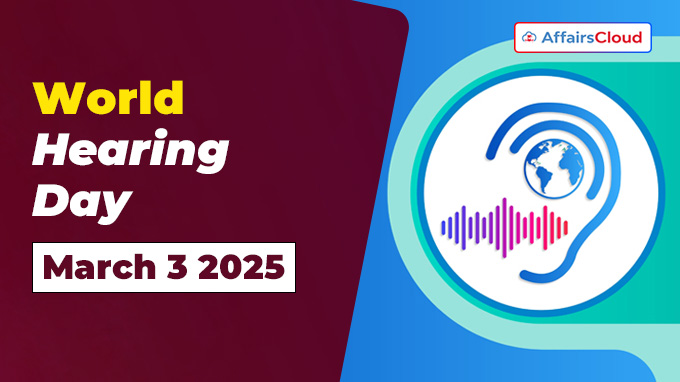 World Hearing Day (WHD) is observed annually on 3rd March across the globe to raise awareness about hearing loss and to promote ear and hearing care. The day also serves as a call to action to address hearing loss and its associated challenges.
World Hearing Day (WHD) is observed annually on 3rd March across the globe to raise awareness about hearing loss and to promote ear and hearing care. The day also serves as a call to action to address hearing loss and its associated challenges.
- 3rd March 2025 marks the observance of the 19th WHD.
- The theme of WHD 2025 is “Changing mindsets: Empower yourself to make ear and hearing care a reality for all!”.
Points to Note:
i.Each year, the World Health Organization (WHO) determines the theme for WHD and develops a range of evidence-based advocacy materials, including brochures, flyers, posters, banners, infographics, and presentations, to support the campaign.
ii.The day has been sponsored by the Office for the Prevention of Blindness and Deafness of the WHO.
Background:
i.The “Beijing Declaration” adopted during the First International Conference on Prevention and Rehabilitation of Hearing Loss held in Beijing (China) in 2007.
- The declaration led to the establishment of “International Ear Care Day” to promote global actions on hearing care.
ii.The first-ever International Ear Care Day was observed on 3rd March 2007. The date was chosen because the numbers 3 and 3 resemble the shape of ears.
iii.In 2016, the day was renamed as”World Hearing Day” to better reflect its broader mission of raising awareness about hearing loss and promoting ear and hearing care worldwide.
Significance:
i.Global Prevalence: Approximately 466 million individuals worldwide, including both children and adults, live with disabling hearing loss. This number is projected to exceed 700 million by 2050, affecting one in every ten people.
ii.Unmet Needs: Over 80% of ear and hearing care needs remain unaddressed globally, leaving a vast majority without essential hearing health services.
iii.Economic Impact: Unaddressed hearing loss imposes an annual economic burden of nearly USD 1 trillion, encompassing productivity losses and social exclusion.
Key Statistics on Hearing Loss:
According to the WHO, hearing loss that is ‘disabling’ is defined as hearing loss higher than 35 decibels (dB) in the better-hearing ear.
i.Approximately 1.5 billion people worldwide, nearly 20% of the global population, experience some form of hearing loss.
ii.Of the 1.5 billion affected, 430 million individuals (including 34 million children) have disabling hearing loss.
iii.By 2050, it is estimated that over 700 million people will have disabling hearing loss, indicating a significant rise in prevalence.
iv.Unaddressed hearing loss imposes an annual global economic burden of approximately USD 980 billion, accounting for productivity losses and social exclusion.
About World Health Organization (WHO):
Director-General (DG)-Tedros Adhanom Ghebreyesus
Headquarters- Geneva, Switzerland
Established- 1948




